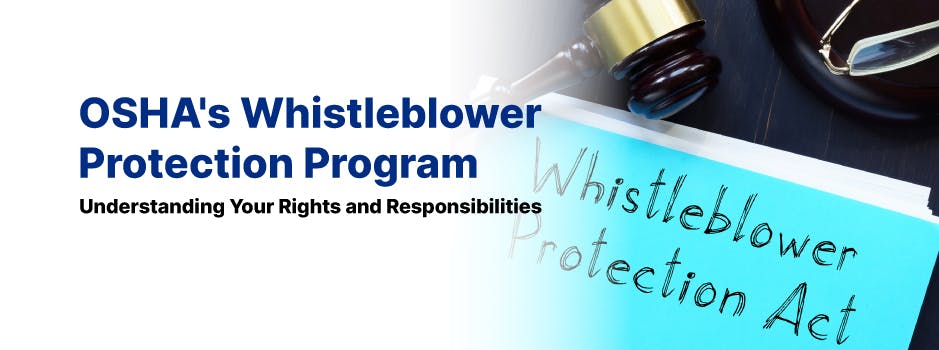Introduction
The Occupational Safety and Health Administration (OSHA) is responsible for ensuring safe and healthy working conditions for employees in the United States. A crucial aspect of achieving this goal is encouraging workers to report potential safety and health violations without fear of retaliation from their employers. To this end, OSHA administers the Whistleblower Protection Program, which safeguards workers who report violations of various workplace safety and health, environmental, and financial regulations. In this blog, we will discuss the Whistleblower Protection Program, the rights and responsibilities of employees and employers, and the process for filing a whistleblower complaint.
Overview of OSHA's Whistleblower Protection Program
OSHA's Whistleblower Protection Program enforces the whistleblower provisions of over 20 federal laws, which protect employees who report violations of workplace safety and health, environmental, financial, and other regulations. The program ensures that workers can raise concerns without fear of retaliation, such as demotion, termination, or harassment.
Some of the federal laws with whistleblower provisions enforced by OSHA include:
- Occupational Safety and Health Act (OSH Act)
- Surface Transportation Assistance Act (STAA)
- Federal Railroad Safety Act (FRSA)
- Clean Air Act (CAA)
- Sarbanes-Oxley Act (SOX)
Employee Rights under the Whistleblower Protection Program
Employees have the right to engage in protected activities without facing retaliation from their employers. Protected activities include:
- Reporting workplace safety and health hazards or violations to OSHA or other appropriate authorities
- Participating in safety and health inspections or investigations
- Testifying in proceedings related to workplace safety and health violations
- Refusing to perform tasks that pose a clear risk of serious injury or death, provided that the employee has no reasonable alternative and has informed the employer of the danger
If an employee experiences retaliation for engaging in protected activities, they can file a whistleblower complaint with OSHA, seeking remedies such as reinstatement, back pay, and compensatory damages.
Employer Responsibilities under the Whistleblower Protection Program
Employers have several responsibilities under the Whistleblower Protection Program, including:
- Complying with all applicable safety and health, environmental, and financial regulations
- Informing employees of their rights and protections under the whistleblower provisions of federal laws
- Establishing a culture that encourages employees to report concerns without fear of retaliation
- Refraining from retaliating against employees who engage in protected activities
- Cooperating with OSHA and other authorities during investigations of alleged retaliation
Filing a Whistleblower Complaint
If an employee believes they have experienced retaliation for engaging in protected activities, they can file a whistleblower complaint with OSHA. The process for filing a complaint includes the following steps:
-
Submit a complaint: Employees can submit a complaint online, by mail, or by telephone. The complaint should include the employee's contact information, a description of the alleged retaliation, and any supporting evidence. It is important to note that each federal law has its own deadline for filing a complaint, ranging from 30 to 180 days after the retaliatory action.
-
OSHA review: OSHA will review the complaint to determine if it meets the basic requirements for further investigation. If the complaint is dismissed, the employee may appeal the decision or pursue legal action independently.
-
Investigation: If the complaint meets the requirements, OSHA will conduct an investigation, which may include interviews with the employee, the employer, and witnesses, as well as a review of relevant documents. The employer will be given the opportunity to respond to the allegations and present evidence.
-
Determination: OSHA will issue a determination based on the evidence gathered during the investigation. If OSHA finds that retaliation occurred, it may order remedies such as reinstatement, back pay, and compensatory damages. If OSHA does not find reasonable cause to believe that retaliation occurred, the employee may still pursue legal action independently.
-
Appeals: Both the employee and the employer have the right to appeal OSHA's determination. Appeals must be filed within a specified time frame and may involve a hearing before an administrative law judge.
-
Settlement: At any point during the process, the employee and the employer may agree to a settlement, which may include remedies such as reinstatement, back pay, or compensatory damages.
-
Tips for Employees and Employers
To ensure a safe and healthy work environment, employees and employers should take the following steps:
For Employees:
- Familiarize yourself with the whistleblower provisions of the federal laws that apply to your workplace
- Keep records of any safety and health concerns or violations that you observe, including dates, times, and witnesses
- If you experience retaliation for engaging in protected activities, document the retaliatory actions and any related communications
- Consult with a knowledgeable attorney, union representative, or employee rights advocate if you are unsure about your rights or the appropriate course of action
For Employers:
- Establish a culture of open communication, where employees feel comfortable reporting safety and health concerns without fear of retaliation
- Train managers and supervisors on the whistleblower provisions of federal laws and their responsibilities for ensuring a non-retaliatory work environment
- Develop clear policies and procedures for addressing employee safety and health concerns and for investigating alleged retaliation
- Seek legal counsel or consult with OSHA's compliance assistance resources to ensure compliance with all applicable safety and health, environmental, and financial regulations
Conclusion
OSHA's Whistleblower Protection Program plays a critical role in promoting workplace safety and health by protecting employees who report violations and encouraging a culture of open communication. Both employees and employers have rights and responsibilities under the program, and understanding these rights and responsibilities is essential for fostering a safe and healthy work environment. By proactively addressing safety and health concerns, cooperating with OSHA during investigations, and promoting a non-retaliatory culture, employees and employers can work together to ensure that everyone can perform their jobs safely and efficiently.

